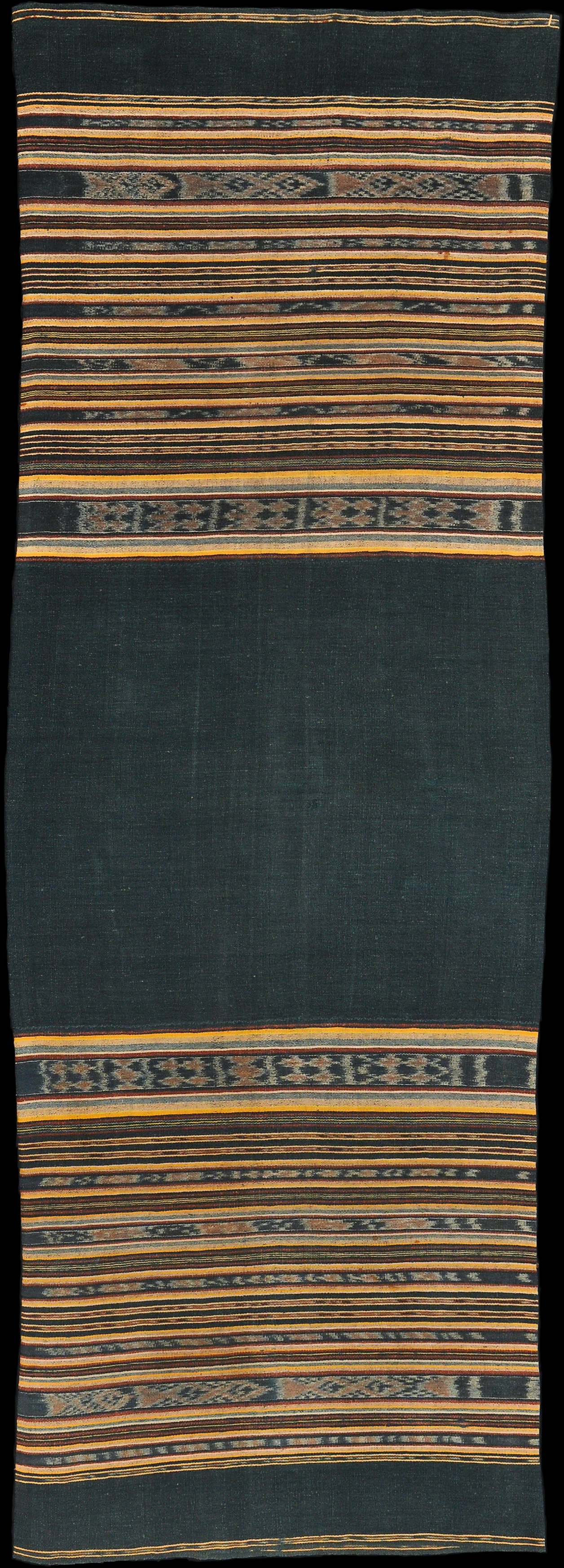| |
 mouse over to magnify mouse over to magnify
| | | | 025 Solor Archipelago, Lembata
Wela (sarong)
| | Locale: | Kedang region of Eastern Lembata; probably made on the island in Kalikur, or made of ikated skeins from eastern Adonara | | Period: | 1915-1940 | | Panels: | 3 | | Design: | Bridewealth sarong, wela, with plain indigo midsection and two panels with ikated bands of varying width showing a variety of geometric motifs, some of which may represent aquatic animals. A few narrow stripes in fine yellow commercial yarn, twined for greater thickness. Note that in the pre-1929 Vatter piece referred to below commercial yarn, probably from Chinese toko, was also used for accent stripes, and also twined. The Balauring port in Kedang had a Chinese trading community already by the early 1900s. | | Size: | 67 x 192 cm (26.3 x 75.5 in) | | Yarn: | Cotton, largely hand-spun | | Comment: | Kedang bridewealth sarong, to be given to groom's family in exchange for male items. Bridewealth sarongs such as these, much longer than a normal sarong, are rarely worn. When worn (for ceremonies) they would be folded down and used as a two tiered sarong so as to fit the bride. Ruth Barnes inform us that there was a taboo on weaving in Kedang region until World War II, the only place excepted being the coastal village of Kalikur, peopled by Muslim immigrants. Such bridewealth sarongs were also 'imported' from Ili Api and eastern Adonara, where they were specially made for the purpose, with indigo midfield, in Kedang considered essential. Two tiny holes, otherwise in excellent state of preservation. | | Background: | Additional information in chapters on Solor Archipelago and Lembata. | | Published: | Woven Languages, 2014.
Ikat Textiles of the Indonesian Archipelago, 2018.
| | Compare: | 178 309 068 | | Sources: | Also similar to sarong made in Ili Api for use in Kedang, in Hamilton, Gift of the Cotton Maiden, Fig. 8-23; and to Ili Api sarong woven around 1900 for Kedang in Khan Majlis, Woven Messages, Fig. 190. Much younger piece posted on tribaltextiles.info on 9 May, 2014, identified as Kedang by Mac Darrell Serizawa. Similar piece, but probably younger and of much more basic design in Herbert F. Johnson Museum of Art (Cornell), Nr. 2008.005.007. Ruth Barnes, the doyenne of Lembata research, identifies our piece as an old Kedang, probably made in Kalikur, possibly in eastern Adonara. It almost certainly dates from before World War II when silk thread became unavailable. | | |
 ©Peter ten Hoopen, 2025
All rights reserved.
|
|


